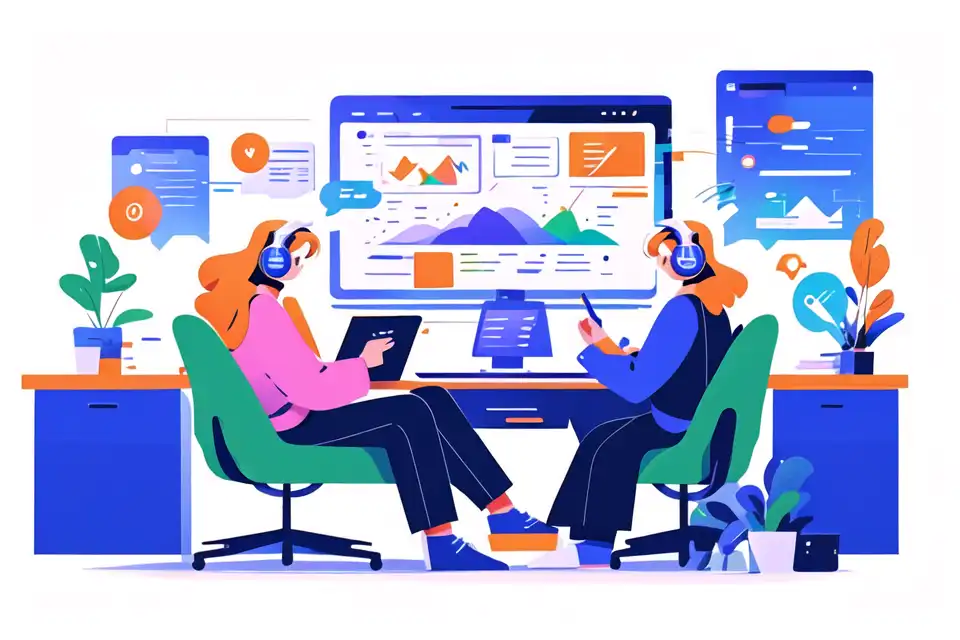Interactive Teaching Tools
Learn about the top tips and strategies in interactive teaching tools
Try Lark for Free
Overview of Interactive Teaching Tools in the Educational Context
Interactive teaching tools are digital resources that facilitate an engaging and participatory learning environment. They can range from interactive whiteboards and educational apps, to online collaboration tools like Lark, a platform that offers a suite of tools for enhanced communication and collaboration.
In the context of education, these tools are designed to stimulate student engagement, promote active learning, and cater to different learning styles. They can be used to present complex concepts in a more understandable and engaging manner, facilitate collaborative learning activities, and offer personalized learning experiences based on individual student needs.
Importance of Interactive Teaching Tools in Modern Learning Environments
The role of interactive teaching tools has never been more pertinent than it is today. In modern learning environments, these tools have become essential for improving the overall teaching and learning experience. They promote active learning, a method proven to enhance students’ understanding and retention of course content.
Research shows that students who engage with course material actively are more likely to remember and understand it better. A report by the U.S. Department of Education found that students who used digital learning tools performed better than those who relied on traditional instruction.
Unlock the power of Lark to elevate your business operations. Discover actionable strategies and best practices in our comprehensive guide.
Benefits of interactive teaching tools
Enhancing Teaching and Learning with Interactive Tools
Interactive teaching tools offer numerous benefits that enhance the educational experience for both teachers and students. For teachers, these tools provide innovative ways to present content, making lessons more engaging and easier to understand. They also offer real-time feedback, enabling teachers to monitor student progress and adjust instruction accordingly.
For students, interactive teaching tools cater to different learning styles, enable personalized learning, and foster active participation and collaboration. For instance, a tool like Lark can be used to create a collaborative virtual classroom where students can work together on assignments, share ideas, and engage in meaningful discussions.
The Positive Impact on Student Engagement and Outcomes
The integration of interactive teaching tools into the educational process has been shown to significantly improve student engagement and learning outcomes. A report by the Gates Foundation found that the use of digital learning tools increased student engagement, leading to improved academic performance and higher graduation rates.
Interactive teaching tools also enhance students’ digital literacy skills, which are crucial in today’s digital era. They foster critical thinking, problem-solving, and collaboration skills, which are essential for success in the 21st century.
Related:
Education Solution | LarkLearn more about Lark can help you with everything mentioned so far in the article.
Implementing interactive teaching tools in education
Steps to Integrate Interactive Teaching Tools into the Classroom or Curriculum
- Evaluate Your Needs: Assess your students’ learning needs and the objectives of your course or curriculum. This will help you determine which interactive teaching tools are most suitable.
- Research Available Tools: There are numerous interactive teaching tools available, each with its unique features and benefits. Conduct thorough research to find the tools that best meet your needs.
- Plan Your Integration: Plan how you will incorporate the chosen tool into your lessons. This includes determining how the tool will be used, when it will be used, and what kind of support or training is required for effective use.
- Implement the Tool: Integrate the tool into your lessons, ensuring that it enhances the learning process rather than distracting from it.
- Monitor and Evaluate: Regularly monitor and evaluate the effectiveness of the interactive teaching tool. Gather feedback from students and make necessary adjustments to ensure optimal use.
Tools and Resources Needed for Interactive Teaching Tools
To implement interactive teaching tools effectively, you will need the appropriate hardware and software, reliable internet connectivity, and digital literacy skills.
Lark can be a valuable resource in this regard, offering a comprehensive suite of tools for communication, collaboration, and productivity. With features like video conferencing, instant messaging, document collaboration, and task management, it can be an effective tool for interactive teaching.
Case studies and examples
Successful implementation of interactive teaching tools in a leading educational institution
Successful implementation of interactive teaching tools in a leading educational institution
A leading university successfully integrated interactive teaching tools into its curriculum, resulting in improved student engagement and academic performance. The university used a combination of interactive whiteboards, educational apps, and collaboration tools like Lark.
Real-world application of interactive teaching tools in a remote learning scenario
Real-world application of interactive teaching tools in a remote learning scenario
A high school in a remote area successfully implemented interactive teaching tools to facilitate distance learning during the COVID-19 pandemic. Tools like Lark were used to create a virtual classroom environment, enabling students to continue their learning from home.
Innovative use of lark as an interactive teaching tool in a university setting
Innovative use of lark as an interactive teaching tool in a university setting
A university effectively used Lark as an interactive teaching tool, leveraging its features to facilitate collaborative learning, real-time feedback, and personalized learning. The tool was used to create a virtual classroom, facilitate group projects, and enhance communication between students and teachers.
Learn more about Lark can help you with everything mentioned so far in the article.
Challenges and solutions
Potential Obstacles when Adopting Interactive Teaching Tools
While the benefits of interactive teaching tools are undeniable, their adoption is not without challenges. These can range from technical issues, such as unreliable internet connectivity and lack of necessary hardware, to resistance from stakeholders who are unfamiliar with or skeptical of the technology.
Strategies to Overcome These Challenges
Successful adoption of interactive teaching tools requires careful planning, adequate support, and continuous evaluation. Here are some strategies to overcome these challenges:
- Training and Support: Provide comprehensive training for educators to understand and effectively use the tools. This can help alleviate any resistance or reluctance to adopt the technology.
- Reliable Infrastructure: Ensure that the necessary infrastructure, such as reliable internet connectivity and necessary hardware, is in place.
- Regular Evaluation: Regularly evaluate and adjust your strategy based on feedback and performance data. This can help ensure that the tools are being used effectively and are meeting the intended objectives.
Future of interactive teaching tools in education
The future of education is unquestionably digital, and interactive teaching tools play a crucial role in this transformation. Emerging trends suggest a continued increase in the use of these tools, with advancements in technology offering even more innovative and effective solutions. From augmented reality and virtual reality to artificial intelligence and machine learning, the future holds great promise for interactive teaching in education.
Learn more about Lark can help you with everything mentioned so far in the article.
Conclusion
Interactive teaching tools are transforming the educational landscape, enhancing teaching and learning experiences, and improving student outcomes. As educators and decision-makers, it is crucial to stay updated and informed about these developments. By understanding the importance of these tools, the benefits they bring, and how to implement them effectively, we can ensure that our students are equipped with the skills and knowledge they need for success in the 21st century.
Do's and don'ts of implementing interactive teaching tools
| Do's | Don'ts |
|---|---|
| Do invest in training for educators | Don't ignore the importance of user feedback |
| Do ensure accessibility of tools | Don't forget to evaluate the effectiveness of tools |
| Do promote a culture of innovation | Don't underestimate the importance of technical support |
Learn more about Lark can help you with everything mentioned so far in the article.
Unlock the power of Lark to elevate your business operations. Discover actionable strategies and best practices in our comprehensive guide.








